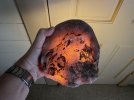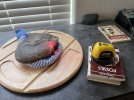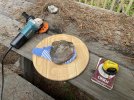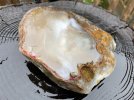- Joined
- May 13, 2019
- Messages
- 8,179
What you mean forever.The 112 would hold an edge longer than an ex-girlfriend could hold a grudge;
The BladeForums.com 2024 Traditional Knife is available! Price is $250 ea (shipped within CONUS).
Order here: https://www.bladeforums.com/help/2024-traditional/
What you mean forever.The 112 would hold an edge longer than an ex-girlfriend could hold a grudge;
Trying to thin the edge on an Arkansas stone, of an old 2-dot 112 in Buck's 440C, was the life lesson 'epiphany' that made me first consider what types of abrasives are a good fit (or not) for given types of steel. That blade basically skated over the stone without much cutting being done, if any at all. Might be the most important lesson I ever learned in sharpening. 440C is actually the steel where I draw the line, in terms of selecting something other than a natural stone to grind it. I eventually used SiC sandpaper to rework the thick factory edge on that blade, and the SiC ate the 440C for breakfast. What a difference.Back in the late seventies: I owned a Buck 112, and a Schrade Uncle Henry. The Schrade was so soft that you could dull it with a sharp glance. But a half-dozen passes on a hard Arkansas stone would bring it back. The 112 would hold an edge longer than an ex-girlfriend could hold a grudge; but it took more than an hour to bring it back to sharp...




That's all pretty cool , if you know what you're doing .I also think that grit progression is more important when using natural stones on harder steels.
While I’m sure it’s ripping out some carbides, sandstone will take metal off of all steels I’ve tried so far, including S35VN, Elmax and CTS XHP (although I haven’t tried any super hard stainless like ZDP-189, and/or super full of carbide stuff like the Rex steels, Z-Max, etc.)
Progressing (as needed depending on edge damage) through several stages, often coarse sandstone - fine sandstone - fine chert - extra fine chert - then stropping will easily get me an arm-hair shaving edge freehand on basically everything in my house. (…soon I’ll be able to sharpen EVERYTHING in the house on natural stones, INCLUDING my straight razor, once I get this monster piece of super-fine/translucent chert finished).
View attachment 2129039View attachment 2129036View attachment 2129035View attachment 2129038
I’m sure diamonds and ceramics give a crisper apex and higher potential sharpness on “super” steels (and do so faster and more efficiently). However as long as you start with an adequately coarse grit natural stone and you’re not jumping up in grits too fast, a working edge should be achievable with natural materials (that you can potentially find in your backyard).
...Natural stones are a beautiful thing when matched up to the steels they were originally intended to sharpen...
Most of those tri-hones are paired with a silicon carbide coarse, if so that will work and an ark will refine the edge.I've never used a modern steel, and I'm looking at a couple of knives that I like the design of, but I'm not sure about S35VN. I have one of those stones on a triangle, and you go from coarse down to very fine, and then sometimes I polish up on the underside of a coffee mug.
I don't really want to buy new sharpening equipment or change my routine. I like it too much.
Is S35VN a good or a bad idea for a stick in the mud like me?
Thank you!
